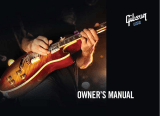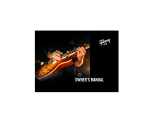
Finished!
Lead wires
(a)
Earth wire
10. Mount the body cover onto the body
Mount the body cover onto the body and secure it with the
screws (Medium).
Screws (Medium)
Retighten the
bolts and nuts.
Earth wire
Lead wire
Screws (Medium)
Neck cover
Ensure that the lead wires of the pickup do not come
off.
CAUTION
CAUTION
Be careful not to pinch the strings when tightening
the screws. After attaching the neck cover, observe
the guitar from the side to make sure that the neck
and body are attached together evenly. If the neck
is not straight, loosen the two bolts, straighten the
neck and retighten the bolts.
Q &A
The guitar does not produce any sound when turned on.
Conrm that the batteries are new and that they have been inserted in
the correct direction.
Ensure that the pickup and battery connectors have been securely
fastened in place.
Q.
A:
A:
Increasing the volume has little effect.
Ensure that the speaker is facing the correct direction. (The
transparent cone should be facing outward.)
Indentation of the transparent speaker cone can also cause the volume
to stay low.
Q.
A:
A:
The coil wire has broken.
Join the two broken ends and continue winding.
The coil wire has a transparent coating and this
should be removed using sand paper or the like.
Following this, ensure that the strands are well
wrapped around each other.
Q.
A:
Turning the tuning peg does not cause the pitch to rise.
The initial string tension may be insufcient. Remove the neck
cover, loosen washer head screw securing the string in question,
increase the tension in the string, and then retighten the screw.
Note that excessive tightening of the tuning peg can damage the
threads on the tuning shaft. If this has occurred, remove the string
in question, move the peg lug to a position beyond the damaged
threads, and then tighten the string.
Q.
A:
A:
The guitar cannot be tuned properly.
Check whether the bridge has become detached or is angeled
incorrectly.
Q.
A:
11. Attach the neck cover and headstock
Attach the neck cover to the neck and secure it
with washer head screws in three locations. Then
attach the headstock.
9. Connect the lead wires and earth wire
Connect the lead wires that have been passed through to the
back to the connector for the lead wires on the circuit board.
In addition, after slightly loosening the screw (a) on the back
of the neck which fastens the second thinnest string, attach
the earth wire on the circuit board to the screw (a) and
re-tighten the screw (a).
10
JR.SCIENTIST

















